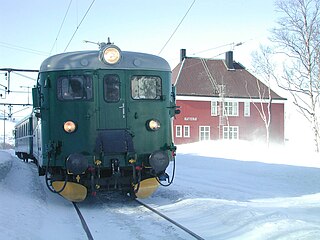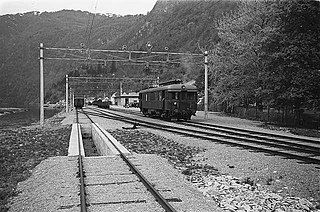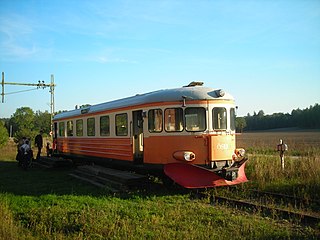
Vygruppen, branded as Vy, formerly the Norwegian State Railways, branded as NSB, is a government-owned railway company which operates most passenger train services and many bus services in Norway. The company is owned by the Norwegian Ministry of Transport. Its sub-brands include Vy Buss coach services, CargoNet freight trains and the Swedish train transport company Tågkompaniet. In 2009, NSB carried 52 million train passengers and 104 million bus passengers. On 24 April 2019, passenger train and bus services were rebranded as Vy.

The NSB El 17 is a class of twelve electric locomotives built by Thyssen-Henschel and Norsk Elektrisk & Brown Boveri (NEBB) for the Norwegian State Railways (NSB). The class was built in two batches, the first delivered in 1982 and numbered 2221–2226, and the second delivered in 1987 and numbered 2227–2232. The traction system of the El 17 was based on the DB Class 120 of Germany and were among the first in the world to feature three-phase asynchronous motors. The units were ordered to be used on the intercity Bergen, Dovre and Sørland Lines, but were plagued with technical faults. The unreliability and lack of sufficient power forced NSB to instead use them in the regional Vestfold and Gjøvik Lines. With the delivery of the El 18, the first series was retired or used as shunters. The second series has been used on the Flåm Line since 1998.

NSB Class 73 is a class of 22 electric multiple units built by Adtranz for the Norwegian State Railways. The four-car trains were modifications of Class 71, which was again based on the Swedish X2. The A-series consists of 16 intercity trains; they were delivered in 1999 and 2000 and are used on the Bergen, Dovre and Sørland Lines. The intercity service was branded as Signatur until 2003. The B-series consists of six regional trains delivered in 2002 and used on the Østfold Line. The regional trains were originally part of the Agenda concept. The trains have a power output of 2,646 kilowatts (3,548 hp) and a maximum speed of 210 km/h (130 mph). They have an overall length of 108 meters (354 ft) and have a capacity for 208 seated passengers in the A-series and 250 in the B-series. The trains have a tilting mechanism allowing for faster travel through curves.

NSB Class 71 is an electric multiple unit used by Flytoget for the Airport Express Trains on the Gardermoen Line of Norway. Sixteen three-car train sets were built by Adtranz Strømmen between 1997 and 1998. The units are capable of 210 km/h (130 mph), connecting Oslo Central Station and other stations in Metropolitan Oslo to the Oslo Airport, Gardermoen, along Norway's only high-speed railway.

NSB Class 69 is an electric multiple unit used by Norwegian State Railways for a variety of commuter trains on the Norwegian railway system, as well as a few medium distance and branch line trains. It is the most common type of trainset in Norway, although the newer NSB Class 72 has also been introduced. All the trains were built by Strømmen.

Class 70 is a four-carriage electric multiple unit operated by Vy on medium distance trains around Oslo. They are operated on the Dovre Line between Oslo and Lillehammer / Dombås and on the Vestfold Line, operating the regional service between Lillehammer and Larvik / Skien.

NSB Di 3 is a class of 35 diesel-electric locomotives built by NOHAB for the Norwegian State Railways (NSB). The class was built between 1954 and 1969, and delivered in two series, Di 3a and Di 3b. They are based on the Electro-Motive Division F7 and are equipped with EMD 567 engines. They have a distinct bulldog nose and were numbered 602–633 (a-series) and 641–643 (b-series). The locomotives had a prime mover that gives a power output of 1,305 kilowatts (1,750 hp). The a-series has a Co′Co′ wheel arrangement, while the b-series has (A1A)(A1A). The b-series has higher top speed, but lower tractive effort.

NSB Class 66 was a three-car electric train used by the Norwegian State Railways for express trains on the Østfold Line to Halden and Gothenburg, and the Sørlandet Line to Kristiansand and Stavanger. The four multiple units were built by Skabo Jernbanevognfabrikk, with motors from Norsk Elektrisk & Brown Boveri, and delivered in 1945–46. They were originally named Class 106, but this was changed in 1956. The trains received the numbering BFM 66.01–04, B 66.31–34 and BS 66.61–64.

NSB Class 68 is a three-car electric multiple unit operated by Norges Statsbaner between 1956 and 2001. It was mainly used for local trains as well as branch lines. The units were built in two series, the A-series being delivered in 21 units between 1956-58 and the B-series in nine units between 1960–61. The motor cars were built by Norsk Elektrisk & Brown Boveri and Skabo while the centre and end cars were built either by Skabo or by Strømmen.

NSB Class 67 is a three-car electric multiple unit operated by the Norwegian State Railways between 1953 and 1995. It was mainly used for local trains as well as branch lines. A total of 18 3-car units were delivered between 1953 and 1955. The motor cars were built by Norsk Elektrisk & Brown Boveri and Skabo while the centre cars were built by Strømmen and the end cars by Skabo.

NSB Class 64 is a class of three electric multiple units built by Strømmens Værksted for the Norwegian State Railways. Delivered in 1935, they were built for the opening of the Hardanger Line and served there until 1985, when the line closed and the trains were retired. They also periodically served on the Flåm Line. The delivery consisted of three motor cars and four carriages, with each train consisting of up to three units. The motor cars were 16.3 meters (53 ft) long, had a power output of 464 kilowatts (622 hp) and were capable of 50 km/h (31 mph). The motor units were given road numbers 505 through 507. Two of the units have been preserved by the Norwegian Railway Club and are at Garnes Station.

NSB Class 62 is the first electric railcar operated by the Norwegian State Railways, between 1936 and 1970. Four units were built by Skabo and Norsk Elektrisk & Brown Boveri in 1931–35, with unit has been preserved by the Norwegian Railway Museum.

NSB Class 83 were a class of three gasoline and later diesel railcars built by Skabo Jernbanevognfabrikk for the Norwegian State Railways. Delivered in 1932, they were originally equipped with two Deutsche Werke prime movers giving a combined power output of 224 kilowatts (300 hp).

NSB Class 86 is a class of diesel-hydraulic multiple units built by Strømmens Værksted for the Norwegian State Railways (NSB). Thirty-eight motor cars and thirty-one trailers were built between 1937 and 1954, split between six subtypes designated a through f. Class 91 was a further delivery of ten units that had a more comfortable interior and designed for regional trains. The trains had good acceleration and a maximum speed of 100 kilometres per hour (62 mph), which made them suitable for most unelectrified lines in Norway. As most of the network gradually became electrified, the class became increasingly used on branch lines.
NSB Class 87 is a class of 25 diesel-hydraulic railcars built by Strømmens Værksted for the Norwegian State Railways. Seventeen a-series units were delivered in 1941 and equipped with 93-kilowatt (125 hp) Deutz prime mover. Eight b-series units were delivered in 1952 and equipped with 110-kilowatt (150 hp) Scania-Vabis prime movers. The trains weighed 15 and 15.5 tonnes and had a maximum speed of 75 and 80 kilometres per hour, respectively for the a and b-series. They were used on many branch lines until the 1960s, when the gradual electrification caused most lines instead to be served with Class 86. The a-series was scrapped in 1972 and 1973, while the b-series remained used between Ål and Hønefoss on the Bergen Line until 1975 and on the Flekkefjord Line until 1981.
NSB Class 88 was a class of six three-car diesel-hydraulic multiple units built by Strømmens Værksted for the Norwegian State Railways. Derived from the German DRG Class SVT 877, the trains were the diesel counterpart of Class 66. The trains were built as express trains on the Bergen Line and the Dovre Line, serving the routes from Oslo to Bergen and Trondheim. The first four units were delivered in 1945 and 1946, but mechanical failures caused them to highly unreliable until 1950. Two more units were delivered in 1958. Retirement started in 1963 and from 1965 the trains were moved to the Røros Line. They left regular service from 1970 and were chopped three years later.

Y6 was a series of diesel railcars operated by Statens Järnvägar (SJ) of Sweden. 378 motor cars and 321 trailers were delivered between 1953-61 by Hägglund & Söner, Svenska Järnvägsverkstäderna, Kalmar Mekaniska Verkstad and Eksjöverken. They were used throughout the unelectrified Swedish rail network during the 1950s to the 1980s. The electrical counterpart of the unit was the X16 and X17.

Oslo Commuter Rail is a commuter rail centered in Oslo, Norway, connecting the capital to six counties in Eastern Norway. The system is operated by Vy and its subsidiary Vy Gjøvikbanen, using Class 69 and Class 72 electric multiple units (EMU). The network spans eight routes and 128 stations, with Oslo Central Station (Oslo S) as the central hub. The trains run on 553 kilometers (344 mi) of electrified mainline railway owned by the Bane NOR. Deficits are financed by the Norwegian Ministry of Transport, although the network also has a ticketing cooperation with Ruter, the public transport authority in Oslo and Akershus. The network is the longest commuter rail network in the Nordic countries, and among top ten in Europe.
Hønefoss Jernbanevogn- og Karosserifabrikk A/S, trading as Høka and at first known as Hønefoss Karosserifabrikk A/S, was a manufacturer of bodywork for buses, trucks and trains. The company was in existence from 1936 to 1968 and was based in Hønefoss, Norway. Among the company's products is Oslo Tramway's SM53 trams, the Trondheim Tramway's GB Class 3 tram and the Norwegian State Railways Skd 221 shunters.

NSB Class 5 or B5 is a series of passenger carriages built by Strømmens Værksted for the Norwegian State Railways. Built between 1977 and 1981, they went through a major upgrade between 2008 and 2012. Sixty-three units were delivered. Each is 25.30 metres long, 3.10 metres wide, and 4.075 metres tall. They weigh 42 tonnes and have a maximum permitted speed of 160 kilometres per hour (99 mph). They are used predominantly on the Dovre Line, the Nordland Line and the Vestfold Line.

















